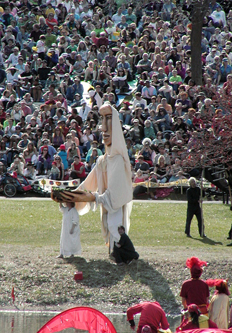Powderhorn Park
Irregularly shaped: roughly between 10th Avenue, 35th Street, 15th Avenue, 14th Avenue, and Powderhorn Terrace
| The May Day Celebration in Powderhorn Park, 2008. Image courtesy of the Wikimedia Commons.
|
For most of human existence, Powderhorn Park was a wetland surrounded by oak savannas--army surveyors had difficulty establishing where the lake ended and ground began in 1839. They sketched approximate boundaries of the lake, and this drawing prompted officials at Fort Snelling to name the lake "Powderhorn," after an animal tusk used to hold 19th century gunpowder.(1)
|
Queer women undoubtedly settled in the Powderhorn park area shortly after this apartment construction. At the time, the Chicago Avenue Trolley carried commuters into downtown and passed three hospitals(3), one college, and the “Print District” along the way. Medical, teaching, and clerical work offered women financial freedom long before equal employment laws—queer women likely took advantage of these occupations to escape the threat of heterosexual marriage. (see also: Foxy's Bar)
By the 1970s, the park served as the locus of a separatist “Lesbian” district, one that stood at odds with the “Gay Ghetto” in Loring Park. In 1982, Powderhorn was the site of a “Lesbian” Twin Cities Pride Festival after Pride Committee members removed “Lesbian” from the event’s title.(4) This split only lasted for the year—the Committee added the “L” word back to its title. Content with this, Powderhorn women returned their focus to the annual May Day Celebration, which has arguably served as a “Lesbian Pride” since its inception in 1975.(4)
This entry is part of:
Minneapolis/St. Paul, MN: 100 Queer Places in Minnesota History, (1860-2010)
(1)Akre, John. "Building a Park Out of a Swamp" From Powderhorn Park: Nature, People, and Community. Minneapolis: THE HORN Newspaper, Powderhorn Park Neighborhood Association (PPNA, and the Powderhorn Park Activities Council, 1990. Page 14.
(2)Akre, Page 16.
(3)The City Hospital, Swedish Hospital, and Abbott Hospital.
(4)Van Cleve, Stewart. "Twin Cities Pride: History of the Parade and Festival: 1969-2009." Pamphlet: Minneapolis, University of Minnesota, 2009.
(5)http://www.hobt.org/mayday/history/index.html. Retrieved 3/7/2010.
Part of Minneapolis/St. Paul, MN: 100 Queer Places in Minnesota History, (1860-1969), (1969-2010)
